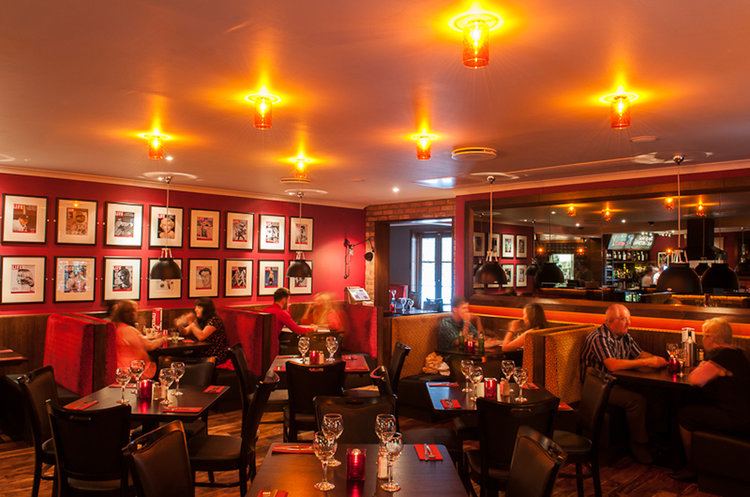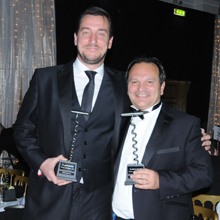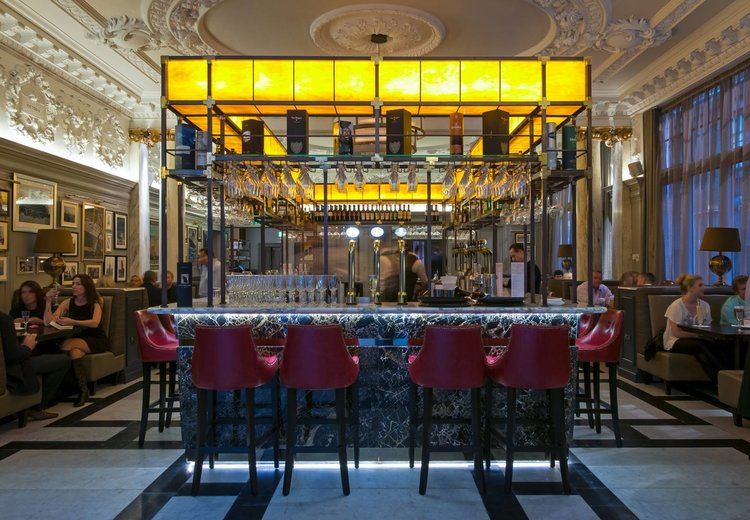
Cousins Mario Gizzi and Tony Conetta are the directors of Di Maggio’s Group – Scotland’s largest family of independent restaurants. Since opening the first Di Maggio’s in Glasgow’s West End in 1983, the company has enjoyed a spectacular period of expansion.
Under the Di Maggio umbrella, there are seven, award-winning Di Maggio restaurants in Glasgow and Greater Glasgow; four Cafe Andaluz – two in Glasgow, one in Edinburgh and one in Aberdeen.

Takes a deep breath…
There is the Barolo Grill in Glasgow; four branches of Amarone spread between Glasgow, Edinburgh and Aberdeen plus The Anchor Line on Glasgow’s St Vincent Place. The company also has fast food outlets in shopping centres in Belfast, Aberdeen, Manchester and in the St Enoch Centre in Glasgow.
Separate from the Di Maggio’s Group, Mario and Tony also have an interest in the expanding group of Pinto restaurants in Glasgow and Edinburgh plus Topolobamba, a Mexican restaurant in Glasgow.
Finally, at least for the moment, there are plans to open yet another restaurant in the same building as The Anchor Line.
The 5pm Dining blog talked to Mario about keeping ahead of the restaurant game for more than thirty years.
You have been doing this very successfully for a very long time. What has the single most important factor in running your restaurants?
MG: Keeping the public happy. We encourage return custom. Glasgow is not London with millions of tourists walking in the door. Glasgow and, to a certain degree, Edinburgh are all about repeat business. We have to give people value for money. Everyone has to leave the table happy and that includes me.

The last few years have been tough. Has value for money been more of a driving factor than in previous years?
MG: I think so. People want deals now but at the same time they want value for money from the deals.
You are often on the floor of your restaurants. Is it important to you to be hands-on?
MG: People like to see Tony and me on the floor. Or they are certainly used to seeing us. If I am to be 100% honest, the more places we open, the less time we can spend at each one. There are only so many Marios and Tonys. We may not be able to spend as much time in each one as when we had fewer restaurants but we try to belt around them.
One of the first things that I always do when I walk in a restaurant is to ask the manger if there is anybody in that I should be talking to. If there is then I will go over and have a few words. Part of what we do is recognition.
You could say that I sell the same chicken as the guy next door. The difference is the ambience, the sauce, the surroundings and making people feel comfortable.
Unusually for the restaurant business, you have a lot of staff who stay with the company for years. Why?
MG: We try to treat people like adults. We recognise that as we get older, people marry and have kids. Traditionally, the restaurant environment is not the best for family life. We always try to make sure that our people get a minimum of two days off.
We have enough staff to do that. If somebody is going through a tough period then we can draft people in from other sites to make sure that they get the time they need. Obviously, remuneration is part of it as well and we try to make sure that we offer an attractive package.
Time is something you can’t buy. Being able to give people time off means a lot in our business.
What have been the biggest changes in the restaurant scene over the last three decades?
MG: Customers are far more knowledgeable now and there are more people eating out. When we opened, eating out was a special occasion. It wasn’t the norm. Today, people might eat out two or three times a week.
I’m now serving the grandchildren of people that I first served when we began. If you came in on a date thirty years ago when you were twenty, you are now fifty and possibly a grandfather.

You operate in Glasgow, Edinburgh and Aberdeen. Are there many differences between them in terms of customer preferences?
MG: Not really. There are differences in terms of market. Edinburgh has more tourists. It’s a European capital. Whether you like it or not as a Glaswegian, Edinburgh is in that top echelon of cities which people want to visit. The rugby also makes a difference.
In Aberdeen, there are two types of customer: Monday to Thursday, there is the business customer. Eating out for lunch isn’t a big thing in Aberdeen. People tend to work all day and then go for dinner at 7.30 or 8pm. At the weekends, it is Aberdeen’s indigenous population out for their Friday and Saturday night.
In Glasgow, it’s a mix of business and shopping. Not so much tourism but guys like Scott Taylor (Glasgow City Marketing Bureau) are doing a fabulous job of bringing in conferences. There is still a lunchtime trade in Glasgow if you are in the right location.
Italian food is popular everywhere but sometimes it seems particularly so in Glasgow. Any theories as to why that might be?
MG: Lots of Italians settled in Glasgow and Edinburgh. Many opened cafes or fish and chip shops and then, in time, they opened restaurants.
It has taken a long time. When we first opened, we would have people, especially the older generations, saying they just want a piece of plain, grilled chicken, absolutely no garlic.

There are more and more Latin American restaurants opening in Glasgow. Pinto and Topolobamba are Mexican. Is South American food the next best thing?
MG: We’re all searching for different taste sensations. Some restaurant sectors haven’t changed for thirty years but people always want something new. We’re all travelling more and experiencing different ingredients, herbs and cultures which we want to eat when we get home. The supermarkets have helped drive that as well. The other thing is that trends tend to be cyclical.
The current Glasgow market is geared towards 18-35 year-olds which is a relatively new thing. And they are knowledgeable and confident customers.
What is it about the restaurant business that gets you out of bed every morning?
MG: I love it. I love the buzz. I’m very lucky, I love my job. Not many people say that. I love walking around the city and meeting people. There are day to day frustrations but I enjoy what I do.
Do you cook at home?
MG: I do a wee bit. I tend to cook the Italian dishes and my wife does everything else. She is a very good cook.
All of your restaurants are shut for the night and you’re going out for a meal. You can go anywhere in the world. Who has your reservation?
MG: If it’s in Glasgow, I love Mother India. If I’m in Italy then there is a restaurant called Bucintoro in Lido di Jesolo which we love.
